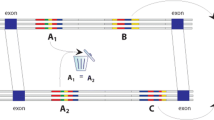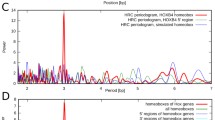Abstract
The HEX gene encodes for a homeodomain-containing transcription factor that controls various phases of vertebrate development. During development, as well as in adult, HEX is expressed in several different tissues including thyroid, liver, lung, mammary gland, haematopoietic progenitors, and endothelial cells, suggesting that this gene is subjected to a complex transcriptional regulation. In this study, we have evaluated the presence of different enhancers in the HEX gene region by using a phylogenetic approach. Several non-coding sequences, conserved between human and mouse, were selected. Four conserved sequences showed enhancer activity in MCF-7 cells. Two of these enhancers (located in the first and third intron, respectively) have been previously identified by other experimental approaches. These elements, as well as one among the new identified enhancers (located 2 kb 3′ to the HEX gene), are able to activate the HEX minimal promoter “in trans.” The activity of the 3′ enhancer was strongly reduced by overexpression of HDAC3.






Similar content being viewed by others
Abbreviations
- LUC:
-
Luciferase
- CAT:
-
Chloramphenicol acetyltransferase
- βGAL:
-
Beta-galactosidase
- CMV:
-
Cytomegalovirus promoter
- RSV:
-
Rous sarcoma virus promoter
- HDAC:
-
Histone deacetylase
- NaB:
-
Sodium butyrate
- TSA:
-
Tricostatin-A
References
Martinez Barbera JP, Clements M, Thomas P, Rodriguez T, Meloy D, Kioussis D, Beddington RS (2000) The homeobox gene Hex is required in definitive endodermal tissues for normal forebrain, liver and thyroid formation. Development 127:2433–2445
Brickman JM, Jones CM, Clements M, Smith JC, Beddington RS (2000) Hex is a transcriptional repressor that contributes to anterior identity and suppresses Spemann organizer function. Development 127:2303–2315
Sekiguchi K, Kurabayashi M, Oyama Y, Aihara Y, Tanaka T, Sakamoto H, Hoshino Y, Kanda T, Yokoyama T, Shimomura Y, Iijima H, Ohyama Y, Nagai R (2001) Homeobox protein Hex induces SMemb/nonmuscle myosin heavy chain-B gene expression through the cAMP-responsive element. Circ Res 88:52–58
Bess KL, Swingler TE, Rivett AJ, Jayaraman PS (2003) The transcriptional repressor protein PRH interacts with the proteasome. Biochem J 374:667–675
Topisirovic I, Culjkovic B, Cohen N, Perez JM, Skrabanek L, Borden KL (2003) The proline-rich homeodomain protein, PRH, is a tissue-specific inhibitor of eIF4E-dependent cyclin D1 mRNA transport and growth. EMBO J 22:689–703
D’Elia AV, Tell G, Russo D, Arturi F, Puglisi F, Manfioletti G, Gattei V, Mack DL, Cataldi P, Filetti S, Di Loreto C, Damante G (2002) Expression and localization of the homeodomain-containing protein HEX in human thyroid tumors. J Clin Endocrinol Metab 87:1376–1383
George A, Morse HCIII, Justice MJ (2003) The homeobox gene Hex induces T-cell-derived lymphomas when overexpressed in hematopoietic precursor cells. Oncogene 22:6764–6773
Thomas PQ, Brown A, Beddington RS (1998) Hex: a homeobox gene revealing peri-implantation asymmetry in the mouse embryo and an early transient marker of endothelial cell precursors. Development 125:85–94
Kubo A, Chen V, Kennedy M, Zahradka E, Daley GQ, Keller G (2005) The homeobox gene HEX regulates proliferation and differentiation of hemangioblasts and endothelial cells during ES cell differentiation. Blood 105:4590–4597
Keng VW, Yagi H, Ikawa M, Nagano T, Myint Z, Yamada K, Tanaka T, Sato A, Muramatsu I, Okabe M, Sato M, Noguchi T (2000) Homeobox gene Hex is essential for onset of mouse embryonic liver development and differentiation of the monocyte lineage. Biochem Biophys Res Commun 20:729–739
Obinata A, Akimoto Y, Omoto Y, Hirano H (2002) Expression of Hex homeobox gene during skin development: Increase in epidermal cell proliferation by transfecting the Hex to the dermis. Dev Growth Differ 44:281–292
Puppin C, Puglisi F, Pellizzari L, Manfioletti G, Pestrin M, Pandolfi M, Piga A, Di Loreto C, Damante G (2006) HEX expression and localization in normal mammary gland and breast carcinoma. BMC Cancer 19:192
Kwan CT, Tsang SL, Krumlauf R, Sham MH (2001) Regulatory analysis of the mouse Hoxb3 gene: multiple elements work in concert to direct temporal and spatial patterns of expression. Dev Biol 232:176–190
Adachi Y, Hauck B, Clements J, Kawauchi H, Kurusu M, Totani Y, Kang YY, Eggert T, Walldorf U, Furukubo-Tokunaga K, Callaerts P (2003) Conserved cis-regulatory modules mediate complex neural expression patterns of the eyeless gene in the Drosophila brain. Mech Dev 120:1113–1126
Zhang Z, Gerstein M (2003) Of mice and men: phylogenetic footprinting aids the discovery of regulatory elements. J Biol 2(2):11
Boccia A, Petrillo M, di Bernardo D, Guffanti A, Mignone F, Confalonieri S, Luzi L, Pesole G, Paolella G, Ballabio A, Banfi S (2005) DG-CST (Disease gene conserved sequenze tags), a database of human-mouse conserved elements associated to disease genes. Nucleic Acids Res 33(Database issue):D505–D510
Denson LA, McClure MH, Bogue CW, Karpen SJ, Jacobs HC (2000) HNF3beta and GATA-4 transactivate the liver-enriched homeobox gene. Hex Gene 246:311–320
Meucci O, Scorziello A, Avallone A, Ventra C, Grimaldi M, Berlingieri MT, Fusco A, Schettini G (1994) Alpha 1°- and alpha 1B-adrenergic receptors mediate the effect of norepinephrine on cytosolic calcium levels in rat PC Cl3 thyroid cells: thyrotropin modulation of alpha 1B-linked response via an adenosine 3′, 5′-monophosphate-protein-kinase-A-dependent pathway. Endocrinology 134:424–431
Francis-Lang H, Zannini M, De Felice M, Berlingieri MT, Fusco A, Di Lauro R (1992) Multiple mechanisms of interference between transformation and differentiation in thyroid cells. Mol Cell Biol 12:5793–5800
Tell G, Pellizzari L, Cimarosti D, Pucillo C, Damante G (1998) Ref-1 controls pax-8 DNA-binding activity. Biochem Biophys Res Commun 252:178–183
Fusco A, Berlingieri MT, Di Fiore PP, Portella G, Grieco M, Vecchio G (1987) One and two-step transformations of rat thyroid epithelial cells by retroviral oncogenes. Mol Cell Biol 7:3365–3370
Wasylyk B (1988) Transcription elements and factors of RNA polymerase B promoters of higher eukaryotes. CRC Crit Rev Biochem 23:77–120
Müller F, Williams DW, Kobolák J, Gauvry L, Goldspink G, Orbán L, Maclean N (1997) Activator effect of coinjected enhancers on the muscle-specific expression of promoters in zebrafish embryos. Mol Reprod Dev 47:404–412
Woolfe A, Goodson M, Goode DK, Snell P, McEwen GK, Vavouri T, Smith SF, North P, Callaway H, Kelly K, Walter K, Abnizova I, Gilks W, Edwards YJ, Cooke JE, Elgar G (2005) Highly conserved non-coding sequences are associated with vertebrate development. PLoS Biol 3:e7
Kuo MH, Allis CD (1998) Roles of histone acetyltransferases and deacetylases in gene regulation. Bioessays 20:615–626
Soufi A, Jayaraman PS (2008) PRH/Hex:an oligomeric transcription factor and multifunctional regulator of cell fate. Biochem J 412:399–413
Pennacchio LA, Ahituv N, Moses AM, Prabhakar S, Nobrega MA, Shoukry M, Minovitsky S, Dubchak I, Holt A, Lewis KD, Plajzer-Frick I, Akiyama J, De Val S, Afzal V, Black BL, Couronne O, Eisen MB, Visel A, Rubin EM (2006) In vivo enhancer analysis of human conserved non-coding sequences. Nature 444:499–502
Rodriguez TA, Casey ES, Harland RM, Smith JC, Beddington RS (2001) Distinct enhancer elements control Hex expression during gastrulation and early organogenesis. Dev Biol 234:304–316
Donaldson IJ, Chapman M, Kinston S, Landry JR, Knezevic K, Piltz S, Buckley N, Green AR, Göttgens B (2005) Genome-wide identification of cis-regulatory sequences controlling blood and endothelial development. Hum Mol Genet 14:595–601
Puppin C, D’Elia AV, Pellizzari L, Russo D, Arturi F, Presta I, Filetti S, Bogue CW, Denson LA, Damante G (2003) Thyroid-specific transcription factors control Hex promoter activity. Nucleic Acids Res 31:1845–1852
Denson LA, Karpen SJ, Bogue CW, Jacobs HC (2000) Divergent homeobox gene hex regulates promoter of the Na(+)-dependent bile acid cotransporter. Am J Physiol Gastrointest Liver Physiol 279:G347–G355
Kleinjan DA, Seawright A, Mella S, Carr CB, Tyas DA, Simpson TI, Mason JO, Price DJ, van Heyningen V (2006) Long-range downstream enhancers are essential for Pax6 expression. Dev Biol 299:563–581
Loudig O, Maclean GA, Dore NL, Luu L, Petkovich M (2005) Transcriptional co-operativity between distant retinoic acid response elements in regulation of Cyp26A1 inducibility. Biochem J 15:241–248
Dentice M, Luongo C, Elefante A, Romino R, Ambrosio R, Vitale M, Rossi G, Fenzi G, Salvatore D (2004) Transcription factor Nkx-2.5 induces sodium/iodide symporter gene expression and participates in retinoic acid- and lactation-induced transcription in mammary cells. Mol Cell Biol 24:7863–7877
Grégoire S, Xiao L, Nie J, Zhang X, Xu M, Li J, Wong J, Seto E, Yang XJ (2007) Histone deacetylase 3 interacts with and deacetylates myocyte enhancer factor 2. Mol Cell Biol 27:1280–1295
Acknowledgments
This study is funded by a grant MIUR to GD (No PRIN No 2007N8P32H_002) and by the FIRB grant RBRN07BMCT (Italian Human ProteomeNet).
Author information
Authors and Affiliations
Corresponding author
Rights and permissions
About this article
Cite this article
D’Elia, A.V., Bregant, E., Passon, N. et al. Conservation across species identifies several transcriptional enhancers in the HEX genomic region. Mol Cell Biochem 332, 67–75 (2009). https://doi.org/10.1007/s11010-009-0175-5
Received:
Accepted:
Published:
Issue Date:
DOI: https://doi.org/10.1007/s11010-009-0175-5




